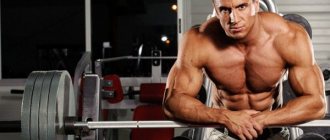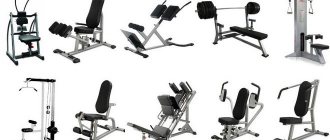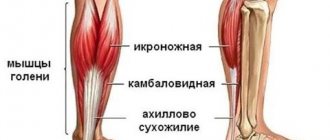© luckyguy123 — stock.adobe.com
Share:
What you need
- Dumbbells
- Barbell
- Exercise equipment
- Horizontal bar
It often happens that an athlete is limited in time and cannot visit the gym more than twice a week. Many people eventually decide that there is no benefit from such rare training and lose a serious attitude towards the training process. How to train in such a situation - not to give up working on your body completely? Intuitive training is definitely not suitable in this case.
However, you can grow even by training twice a week; for this you need three things: systematicity, regularity and consistency. The only option to put this into practice is a two-day mass split. By following this training system, you will make steady progress even with two visits to the gym per week.
Read this article to the end and find out how to properly build this training program and what results in developing your own body you will achieve with its help.
Creating a two-day split[edit | edit code]
Two-day split
Well, finally, the first stage of the training has been completed - circuit training, and you can move on to the next stage, which involves separate training of muscle groups, otherwise called split. The working weights have increased and it becomes impossible to fully pump the entire body in one workout. In addition, the body muscles no longer have time to recover for the next workout due to the same reason for the increased weights. Therefore, the muscles are divided into several groups, each of which is worked out in a separate workout. At first, for several months you will have to work out in a two-day split - the muscles of the body are divided into two groups. Three training sessions are held per week. Usually muscles are divided according to the “up-down” type or the “pull-pull” type. “Upper-bottom” means that in the first workout the muscles of the upper body are loaded, and in the second - the lower body. A push-pull split means doing a variety of pulls in the first workout and bench presses in the second. Below are some examples of two-day splits using different ways to separate muscle groups.
Cardio and cool down
Endurance is one of the most important goals, trying to achieve which you will increase the strength and duration of muscle work, which will improve the quality of life outside the gym.
This 5-day mass training program is an effective split that simultaneously increases endurance, mobility and core strength because it uses a large number of muscle groups and gives them time to rest and recover.
When you start lifting comparatively heavier weights, the proportions of your form will be disrupted due to weakness of individual muscles, lack of endurance and mobility. Let's try to prevent these problems.
Warm-up
To pre-warm up, start with 3 minutes of walking alternating with 30 seconds of high-intensity sprinting. Finish with 90 seconds of walking.
This stress will prepare the body for a large anaerobic load and raise the overall temperature.
Hitch
I don't like to quote research, and I certainly won't go too deep into the science, but high-intensity interval training is guaranteed to increase muscle strength and quality.
Plan:
- 5 minutes. walking at a fast pace
- 30 sec. running
- 30 sec. walking
- 30 sec. sprint
- 30 sec. walking
- 45 sec. sprint
- 1 min. walking
- 1 min. running
- 1 min. walking
- 30 sec. sprint at maximum speed
- 1.5 min. slow walking with a gradual stop
Tips for Cardio and Cooling Down
This may sound like a special formula, but in reality it is not. The above plan is only a rough template and does not need to be followed exactly.
I just want you to understand the importance of pre-warming your body to prepare for the rigors of strength training. Don't focus on fractions of seconds if you have low endurance and increase your walking (rest) periods and try to rest less
Don't focus on fractions of seconds if you have low endurance and increase your walking (rest) periods and try to rest less.
Program 1[edit | edit code]
Top-bottom muscle separation. In the first week, two upper and one lower workouts are performed. In the second - two bottoms and one top. Trainings are held on Mondays, Wednesdays and Fridays.
For example:
Monday is the first workout, Wednesday is the second, Friday is the first, Monday is the second.
First training. Top[edit | edit code]
The main muscle groups of the upper body are the back, chest, deltoids and arms. For each of them, at least one basic exercise must be performed. Based on this, the training is built.
- Bench press on a horizontal bench 3x8-10
- Fly (or press) on an incline bench. 3x8-10
- Upper pulley to chest 3x8-10
- Bent-over barbell row (or seated chest row) 3x8-10
- Seated barbell press in Smith machine 3x8-10
- Standing biceps curl 2x10-12
- Vertical block downward triceps press 2x10-12
Second training session. Bottom[edit | edit code]
- Squats with a barbell on the shoulders 3x8-10
- Platform leg press 3x8-10
- Deadlift 3x8-10
- Deadlift on straight legs 3x8-10
- Lying leg curls in a special machine 3x8-10
- Standing calf raises in the machine 2x12-15
Rest interval between training days
As we have already found out, rest is one of the elements that is very important when gaining weight. But if it’s clear about how much sleep you need, then the next question arises: how to distribute training days among the week? By working out just two days a week, you can take a fairly long break between workouts. The first training day is better to start on Tuesday, because Monday, as practice shows, is a rather difficult day, and the body is just entering the work week. The second training day is best set on Friday.
This way, between training days, you get three days of rest, and taking into account the fact that different muscle groups are involved on different days, the body will recover perfectly, and it is very difficult to get overtrained.
Program 2[edit | edit code]
Based on the exercises given above, or adding them a little, you can vary the split systems. For example, add deltoids or arms to the training of legs, respectively, removing them from the first training to the top. Then the split might look like this:
First training[edit | edit code]
- Incline bench press 3x8-10
- Dumbbell fly on a horizontal bench 3x8-10
- Upper pulley to chest 3x8-10
- Bent-over barbell row 3x8-10
- Standing biceps curl 2x10-12
- Dips with weights 2x10-12
Second training[edit | edit code]
- Squats with a barbell on the shoulders 3x8-10
- Platform leg press 3x8-10
- Leg curls in the machine 3x8-10
- Standing calf raises in the machine 2x12-15
- Seated vertical chest press in Smith machine 3x8-10
- Dumbbell swings from the sides up while standing 3x10-12
- Dumbbell swings while standing at an incline 3x10-12
Recommended Supplements
Without proper nutrition, any supplements and sports nutrition turn into a waste of money. I'll probably be the first to advise choosing a can of protein over a couple of kilos of good meat. But I hope that you already know this without me.
For those who do not have problems with the diet, below I provide a list of supplements that enhance the effects of this training method.
Pre-workout supplements
I prefer to train with pretrains while cutting, because with a low calorie diet, I no longer have the strength to maintain the normal intensity of the workout. But when gaining mass, you also need to give it your all, and if you are natural, then you also invest in 1 hour, the maximum is to finish the workout in 1 hour and 20 minutes.
Choose a blend that is moderate in stimulants.
Protein
In my opinion, the most pleasant-tasting protein is strawberry or babana. And there you can safely take it without additives. Oh yes, by company, take any from a store you trust. I personally prefer Optimum Nutrition. But you can take another brand of whey concentrate; this is the best option in terms of price-quality ratio.
The most optimal composition without any “surprises” in the form of an imaginary increased content of amino acids, which are easily digestible, or a large amount of fat with carbohydrates, which are already sufficient in the diet.
Calculation of the daily requirement should be done based on your protein requirement for the day and the amount you get from food. Personally, I drink one or two scoops in the morning and the same amount after training.
BCAAs
I use this supplement in the morning and after training, and can also take it on time if I haven't eaten well that day. It helps keep muscles from breaking down, especially in the morning and after exercise when cortisol levels rise. You can take from 5 to 30 grams. In essence, this is the same protein, but very quickly digested, which will enter the bloodstream faster than protein from chicken breast or even eggs. If money is tight, you can do without it.
Creatine
I have already written about him. This proven and effective sports nutrition will help you train harder and recover more effectively. Highly recommend. Beginners can start using it no earlier than after half a year of training, or better yet, after a year. This way you will accelerate your body’s own potential and then strengthen your capabilities. It can be taken 5 grams on an empty stomach with grape juice or honey. I personally take it in cycles, as it seems to me that it works better this way.
Program 3[edit | edit code]
Below is an example of a two-day push-pull split:
First training. Pull[edit | edit code]
- Barbell row (lower block) to the stomach 3x8-10
- Upper pulley to chest 3x8-10
- Deadlift on straight legs 3x8-10
- Lying leg curls in the machine 3x8-10
- Standing biceps curl 3x8-10
Second training session. Push[edit | edit code]
- Squats with a barbell on the shoulders 3x8-10
- Platform leg press 3x8-10
- Bench press 3x8-10
- Incline Dumbbell Press 3x8-10
- Smith machine seated chest press 3x8-10
- Vertical block triceps presses 2x10-12
Brief explanations of the programs[edit | edit code]
These programs do not include abdominal exercises. There are several reasons for this. Firstly, the abs are very heavily loaded during other exercises, such as squats, bench presses, barbell rows, etc. In addition, direct work on the abs is very energy-consuming, and therefore its implementation will negatively affect the recovery and growth of other muscles. That is why one of the most famous trainers, Vince Gironda, prohibited abdominal work in his gym.
Don't forget about a general warm-up before training and one or two warm-up sets of each exercise before performing work.
Remember to vary your workouts. If the first workout began with chest training, then a similar second workout should begin with back training. The only exceptions are squats. Due to their complexity, they should come first on the day of leg training.
Thus, after practicing a two-day split for some time and exhausting its possibilities, you can move on to a three-day split (see Three-day split for beginners).
Basics of training
The principle of the split technique is simple - we “divide” the body into large muscle groups (for example, back, arms, legs, etc.) and train them on a separate day.
Benefits of the training program:
- A weekly split allows enough time for muscle rest and recovery between workouts. This is an excellent indicator for mass work.
- The scheme is suitable for bodybuilders with an average and professional level of training.
- Unlike a regular workout (1-1.5 hours), the duration of the split is much shorter - 25-45 minutes.
- The intensity of the workout increases, as the work is aimed at one, maximum two muscle groups. This way you have more strength and can fully train a specific muscle.
The key points of split training are correctly selected exercises, training intensity, minimal rest between work. On rest days, it is not recommended to perform any physical exercise, just eat well, do not forget about vitamins, sports nutrition and good sleep. Then the effect of the weekly scheme on weight will be obvious.
Training Tips
The main reason for lack of progression, injury and muscle imbalance is a violation of the training plan and technique. Therefore, it is important to remember the basic tips that will help you practice correctly:
- Remember that small muscle groups are most likely to be stressed in both sessions. Therefore, you cannot overdo it by adding unnecessary exercises for them. This applies to biceps, triceps, abs and partially deltoids.
- Aim to complete your core workout in one hour. This will allow you to finish before your body's cortisol levels begin to rise.
- Warm-up before strength work should include dynamic movements and cardio (5-10 minutes).
- Use supersets and dropsets in splits no more than once every two weeks.
- Try to ensure that the load is applied evenly to all muscle groups during the split.
Warm-up and stretching
Remember a simple truth. Warm-up is mandatory, stretching is highly recommended. Warm-up occurs at the beginning of the workout; without it, starting the strength part will unjustifiably increase the risk of injury, as well as deterioration in performance. Stretching after training will slightly reduce pain and speed up muscle recovery. Regardless of the load, you need to warm up and stretch all the muscles of the body.
Sets and reps
The number of sets and repetitions should be determined by the current goal of a particular cycle. For muscle gain, the optimal range is from 6 to 10 repetitions, strength development – from 3 to 6 repetitions. As part of losing weight, it is better to increase the number of repetitions in a set to 12-15, although a man can do it according to the standard scheme, simply by adjusting his diet.
Equipment
No equipment required. The only thing that will be relevant almost always is hand protection. Wearing gloves will help protect your skin and reduce pain when lifting heavy weights. The training belt should only be used on the last sets, when maximum weights are taken, but be aware of the compression it creates. Wearing a belt more than 45-50 seconds is strictly prohibited. I consider the use of straps and loops unnecessary, despite their popularity. This almost always causes the forearm muscles to lag behind and become the weak link in most exercises.
Weight of weights
It is considered optimal for a split system to work with weights of 60-65% of the one-time maximum. On the last approaches, it is allowed to take 70-75% of the load, but no more. To correctly track your working weights, I recommend keeping a diary or using your phone (any text document, application, calendar, etc.).
Nutrition and sports supplements
Mandatory supplements are protein, creatine (courses, 2 months on/1 month off), vitamin and mineral complexes and omega-3. If you lack energy and vigor before training, you can use green tea extract. BCAA is advisable only for morning cardio, 20 minutes before the start of training.
How many times a week to train
As much as your lifestyle and work schedule allows. The minimum reasonable number of classes per week is 2. The optimal number is 3. If you consider yourself an advanced athlete and have been training for several years, you can train 4 times a week, separating muscle groups more carefully.
What it is
Split training is a program divided into several parts, each of which is dedicated to pumping a specific muscle group. The classic scheme is three-day (this is just one of many options):
- on the first training day (for example, Monday) all the load goes on the deltoids, back and triceps;
- in the second (Wednesday) - on the chest, forearm, biceps;
- on the third (Friday) - on your feet.
Muscles can be grouped in different ways, the schemes can be variable: 2, 3, 4 and even 5 days. This type of training has two distinctive features. Firstly, the loads are quite large, so such training systems are suitable only for advanced athletes. Secondly, intensive growth of muscle mass is observed, since the rehabilitation period for each part of the body increases, and the fibers have time to fully recover.
What is the difference from a conventional split system?
Functionally, from the user's point of view, a multi-split is not much different from a conventional air conditioner. The differences are as follows:
Installation features
Place the external unit in an authorized or inconspicuous place. Whenever possible, we try to minimize the total length of the routes.
It is necessary to provide for a sufficiently efficient drainage of drainage water - after all, the compressor power is increased, in proportion to the number of connected indoor units. (remove, does not depend, drain from each internal)
High-level systems include a distribution manifold; in low-end systems, pipes are laid from each internal module to the external one.
Number of premises served
Entry-level devices serve 2-4 rooms. Many manufacturers offer such models. The most powerful ones cope with 6-8 rooms.
Route length
For most models, the total length of the route is limited to 15 meters per indoor unit. In practice, this allows for 10+20 or 15+15 routing for two-room models. This allows you to cover all rooms facing one facade. In this case, the pipelines must be installed in one piece, without solder joints.
Price comparison
Despite the smaller number of parts and components, multi-splits are more expensive than separate split systems for the same number of rooms. This can be explained by the high requirements for the performance and reliability of the external unit.
VIDEO: Comparative analysis of split systems and multi-split systems -










